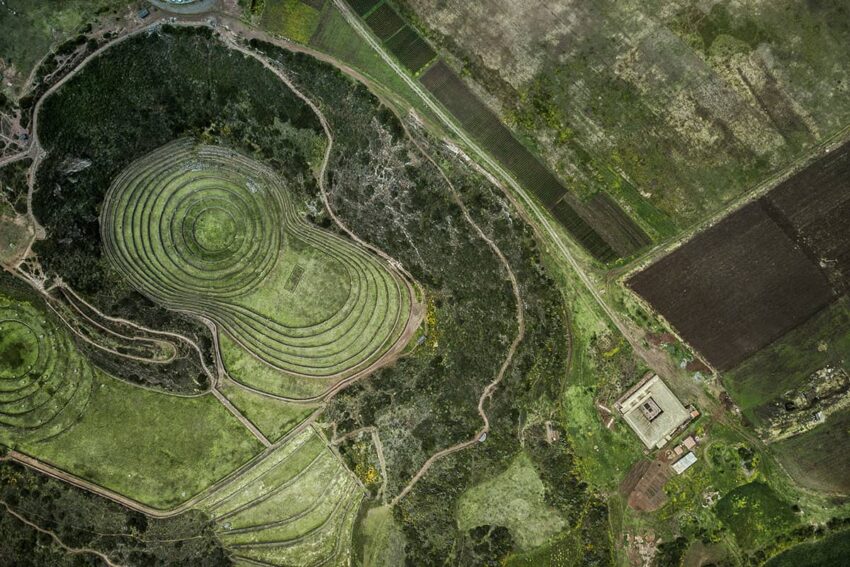The Moray Inca Ruins are a testament to the ingenuity of the Inca civilization. Nestled in the Sacred Valley of Peru, these ruins are famous for their large circular terraces. Historians believe the Incas used them for agricultural experiments. The site’s unique design creates microclimates, allowing the study of crops under different conditions. The Moray Inca Ruins remain a fascinating and mysterious part of Inca heritage, attracting scholars and tourists alike.
Get your dose of History via Email
Historical Background of Moray Inca Ruins
The Moray Inca Ruins, discovered in the early 20th century, are a marvel of engineering. The Incas, a civilization that thrived in the Andean region, built this site. They were known for their advanced agricultural practices. The ruins consist of several terraced circular depressions. These terraces likely served as an agricultural laboratory. The Incas inhabited this region until the Spanish conquest in the 16th century. Moray then fell into disuse and was eventually reclaimed by nature until its rediscovery.
Shirley and Chadwick, explorers from the United States, stumbled upon Moray in 1931. They were mapping the Urubamba Valley. Since then, the site has undergone archaeological excavations and studies. The Incas, who built Moray, were master builders. They created a complex society with a vast empire. Moray’s design reflects their understanding of agriculture and climate.
Although the Incas left no written records, their legacy lives on through structures like Moray. The site’s purpose remains a topic of debate among historians. However, its sophisticated design suggests it played a significant role in the Inca civilization. The terraces’ varying altitudes and orientations create distinct environmental conditions. This feature would have been invaluable for crop experimentation.
After the Spanish conquest, the Moray site was abandoned. Over time, it became buried under soil and vegetation. The local population did not inhabit Moray after the Incas. It remained untouched until its rediscovery in the 20th century. The site has not been the scene of any historically significant events since the fall of the Inca Empire. However, it stands as a silent witness to the ingenuity of its creators.
Today, Moray is an important archaeological site. It provides insight into Inca agricultural practices and their ability to adapt to the environment. The site is also a popular tourist destination. It offers a glimpse into the past and the sophisticated culture of the Incas.
About Moray Inca Ruins
The Moray Inca Ruins are an architectural wonder. They are located in the Sacred Valley, near Cusco, Peru. The site features several circular terraces carved into the earth. These terraces descend like steps into the ground. They create a series of microclimates. The largest depression is approximately 30 meters deep. The terraces are built with retaining walls filled with fertile soil. They have an intricate irrigation system.
The construction of Moray showcases the Incas’ mastery of stonework and engineering. They used local materials, such as limestone, to create the terraces. The walls are built with a technique known as “dry stone.” This method involves fitting stones together without mortar. The Incas designed the terraces to resist erosion and earthquakes. This durability is a hallmark of Inca architecture.
One of the most striking features of Moray is its irrigation system. The Incas engineered channels to direct water from nearby springs to the terraces. This system allowed for the cultivation of crops throughout the year. The design also prevented waterlogging and soil erosion. The precise arrangement of the terraces maximized sunlight and temperature control.
The architectural highlights of Moray include its concentric circular design and the use of space. The terraces form natural amphitheaters. They blend seamlessly with the surrounding landscape. The layout of Moray is aesthetically pleasing and functional. It demonstrates the Incas’ ability to integrate their structures with nature.
The methods of construction and the materials used at Moray are consistent with other Inca sites. However, the purpose and function of the terraces set it apart. The site’s unique design suggests it was more than just a farming area. It was likely a center for agricultural research and development. The Incas could have used Moray to improve crop yields and adapt to the high-altitude environment.
Theories and Interpretations
Several theories exist about the purpose of the Moray Inca Ruins. The most widely accepted theory is that the site was an agricultural laboratory. The Incas used it to experiment with crops. The terraces’ varying temperatures simulate different ecological zones. This feature would have allowed the Incas to test plants from various regions.
Some scholars suggest that Moray had a ceremonial or religious significance. The circular design may have had astronomical alignments. These could be related to the Inca calendar and agricultural cycles. However, there is no concrete evidence to support this theory. The site’s primary function appears to be agricultural.
The mystery of Moray also lies in the lack of historical records. The Incas did not have a written language. Most of what is known about them comes from archaeological evidence and Spanish colonial accounts. This gap in information has led to various interpretations of Moray’s purpose.
Archaeologists have used carbon dating to determine the age of the site. They have also analyzed pollen samples from the soil. These methods have provided insights into the types of crops grown at Moray. The findings support the theory of agricultural experimentation. However, the full extent of the site’s use remains a topic of research.
The interpretations of Moray’s function are matched to historical records through comparative analysis. Researchers look at similar Inca sites and practices. They also consider the broader context of Inca society and its emphasis on agriculture. Despite the mysteries, Moray is a significant piece of the Inca puzzle. It offers clues to their advanced understanding of the natural world.
At a glance
Country: Peru
Civilization: Inca
Age: 15th century AD

